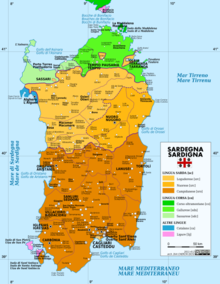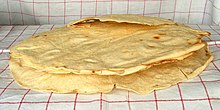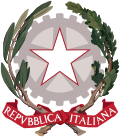| Sardinia region | |
| Capital | Cagliari |
|---|---|
| Residents | 1.639.591 (2019) |
| surface | 23,949 km² |
| no tourist info on Wikidata: | |
| location | |
 | |
Sardinia is after Sicily the second largest island in the Mediterranean. The island belongs to as an autonomous region Italy.
Regions

| The Sardinia region consists of the Provinces | |
| Sassari Province | |
| Nuoro Province | |
| Oristano Province | |
| Province of South Sardinia (Sud Sardegna) | |
| Metropolitan city of Cagliari | |
places
- Alghero: medieval city on the northwest coast
- Arzachena: Place near the Costa Smeralda with numerous archaeological relics
- Cagliari: in the south of the island capital
- Iglesias
- Nuoro (Nugoro in the Sardinian language)
- Olbia: (Ferry) port city in the northeast
- Oristano
- Sassari
Other goals
- Capo Comino - promontory on the northeast coast
- Parco Regionale di Porto Conte with the Neptune Rotten (Grotte di Nettuno)
- Sinis Peninsula
background
language

The colloquial and official language in Sardinia is Italian. The Sardinian language is part of the island's tradition (su sardu or limba sarda). There are still around 1–1.3 million speakers of this Romance language. However, its prevalence and practical application is declining from generation to generation. Among other things, because the language of instruction in schools is Italian.
A regional law of 1997 and a law of the Italian Republic of 1999 recognized Sardinian as a minority language. An equality with Italian, as in South Tyrol or in the Aosta Valley, has not yet been achieved. In addition to the 5 main dialects (Nuorese, Gallurese, Sassarese, Logudorese and Campidanese) there are other linguistic minorities in Sardinia: On the two islands in the south-west of Sardinia (especially Carloforte and Calasetta) a Ligurian dialect, the so-called "Tabarchino", and a Catalan dialect is spoken in Alghero in the northwest (Catalan L'Alguer, Sardinian S'Alighera, Spanish Alguer). The differences between the individual forms are at least as great as between Lower Bavarian and Saxon.
For travelers from abroad, it is important that knowledge of English, especially in the elderly, can only be assumed to a limited extent. Increasingly, English skills are getting better and better among the younger population group. Even with French or Spanish you get along quite well overall.
getting there
Naturally, the island can only be reached by ship or plane, although your own vehicle can easily travel with you thanks to the numerous ferries. The costs vary greatly depending on the season. For locals, there are usually cheaper tariffs. So-called Sardinian tariffs are often more expensive for the ferries than other offer tariffs (COB, round trip, etc.)
By plane
You can get to Sardinia with the following low-cost airlines: Ryanair, Easyjet, Eurowings and Volotea. There are airports at 1 Aeroporto di Cagliari-Elmas(IATA: CAG), 2 Alghero airport(IATA: AHO) and 3 Olbia airport(IATA: OLB).
By boat

A number of ferry companies combine this mainland Italy (and also France and Spain) with the island, keeping an overview is not easy.
- 4 Olbia located in the northeast of the island
- Genoa, Ferry connections through Moby Lines (12x / week) and Tirrenia (5x / week), approx. 10 hours
- Livorno (Height of Pisa), ferry connections through Moby Lines (14x / week) and Grimaldi Lines (14x / week), approx. 7 - 8 hours
- Piombino (between Livorno and Rome), ferry connections through Moby Lines (7x / week), approx. 5 - 6 hours
- Civitavecchia at Rome, Ferry connections through Moby Lines and Tirrenia
- 5 Golfo Aranci, small ferry port a little north of Olbia
- Livorno (Height of Pisa), ferry connections through Sardinia Ferries (16x / week), approx. 6½ hours
- Piombino (between Livorno and Rome), ferry connections through Sardinia Ferries (6x / week), approx. 6½ hours
- Porto Vecchio on Corsica, Ferry connections through Sardinia Ferries (5x / week), approx. 3 hours
- Nice in South France, Ferry connections through Sardinia Ferries (2x / week), approx. 12 hours
- 6 Porto Torres located in the northwest of the island
- Genoa, Ferry connections through Grandi Navi Veloci (5x / week) and Tirrenia (9x / week), approx. 12 hours
- Civitavecchia at Rome, Ferry connections through Grimaldi Lines (5x / week), approx. 7½ hours
- Barcelona (E), ferry connections through Grimaldi Lines (5x / week), approx. 12 hours
- Porto Vecchio and Ajaccio on Corsica, Ferry connections through Sardinia Ferries (once a week), approx. 3½ hours
- Toulon in South France, Ferry connections through Sardinia Ferries (3x / week), approx. 7 hours
- Marseille in South France, one ferry connection each through Corsica Linea and La Méridionale per week
- 7 Cagliari, the island's capital is located in the south of the island
- 8 Arbatax, located on the east coast of the island
- Genoa, Ferry connections through Tirrenia (2x / week), approx. 17½ hours
- Civitavecchia at Rome, Ferry connections through Tirrenia (2x / week), approx. 10½ hours
There is also a regular ferry connection to Corsica:
- 9 Santa Teresa di Gallura located in the north of the island
- Bonifacio, Ferry connections through Moby Lines (4x / day) and BluNavy (4x / day), approx. 1 hour
mobility
Public transportation
By train





Most of Sardinia's rail links are operated by the state railway company Ferrovie dello Stato / Trenitalia ensured the main axes of Porto Aranci resp. Olbia in the northeast about Macomer (with a stitch line after Sassari and Porto Torres in the north-west), Oristano on the west coast and the island capital Cagliari run along the most important road axes. Other secondary lines run between Cagliari and Iglesias resp. Carbonia in the southwest.
Secondary rail connections are provided by the arst / Trasporti Regionali della Sardegna operated, so the connection of Sassari to Alghero, of Macomer to Nuoro as well as from Monserrato at Cagliari to Isili.
Tourist narrow-gauge railway lines of the (Trenino Verde run between Sassari - Tempio - Palau in the North, Macomer and Bosa in the west as well Arbatax and Mandas as Mandas - Laconi in the East. The routes are very picturesque and the travel times are correspondingly long.
By bus
Sardinia is cheap to travel by bus. That through the arst / Trasporti Regionali della Sardegna operated bus network is well developed and you can reach all larger towns.
taxi
Driving a taxi, on the other hand, is very expensive and some journeys from the airport to the holiday home cost a multiple of the cheap ticket for a cheap flight. If you want to avoid this, ask e.g. at the Centro Servizi Tartaruga in Budoni about transfer options. Tel. 0784 844173 (Italian, German, English)
Hitchhiking
Hitchhiking in Sardinia is relatively easy and problem-free. It is also more common than in Germany, for example, and older people are often standing on the street waiting for a lift. One reason for this is of course the lack of public transport infrastructure.
In the street
The road network in Sardinia has been greatly expanded in recent years and is in relatively good condition. Problems caused by different spellings of localities in Italian and Sardinian are somewhat challenging. Somewhat unusual in Sardinia is that signposts are often far in front of the intersection for which they apply, and at the intersection itself the branches are sometimes barely marked.
The expressways are single-lane and two-lane and allow rapid progress. In the context of new construction and renovation sections, speed restrictions can be signaled over longer distances, which the local population only adheres to to a limited extent. Only a few small back roads (also marked as such on maps) are gravel and should only be driven on with off-road vehicles.
There are (in contrast to mainland Italy) no toll roads.
The speed limits are as follows:
- In the village 50 km / h
- Out of town 90 km / h
- Expressways 90 km / h (there are only a few sections on which 110 km / h are signposted)
Driving outside of town must be done with dipped headlights at all times of the day.
The driving style differs from the German-speaking countries due to the temperament of the Sardinian motorists. In any case, you should drive carefully, anticipate possible maneuvers by other road users and be prepared for everything (!). Oncoming drivers often cut corners. In recent years there has been an increasing focus on speed and alcohol controls.
There are two designated petrol pump lanes at the petrol stations: with service ("servito", approx. 20 cents / l surcharge) and without service (senza servizio / "fai da te"). Credit card payments are generally not a problem. The petrol station network is not too dense, but you can always find a petrol station along the main traffic axes and on the approach roads of the larger towns.
By bicycle
A bike tour through Sardinia is particularly recommended on field and forest paths, because the most beautiful beaches cannot be reached by car or bus. Because of the many thorns and thorns of wild bushes, a special wheel cover with a thick profile is recommended. However, one should avoid main roads because most Sardinians do not expect to meet individual cyclists. There are hardly any dedicated bike paths like in Germany. Since it is very warm, especially in the summer months of July and August, you should always have enough fluids in your luggage. A GPS device or a bike map is a must!
Tourist Attractions

- East coast beaches: Between San Teodoro and 1 Orosei all beaches are worth visiting. In 1 San Teodoro and 2 Budoni long, flat sandy beaches with lagoons with flamingos. In 3 Capo Comino the most beautiful dune landscape on the east coast, then the 4 Berchida Beach in the nature reserve, and finally the fish-rich 5 Cedrino estuary delta in Orosei.
- Costa Smeralda in the north-east of Sardinia, beautiful beaches, but the publicly accessible ones are overcrowded.
- 1 Arcipelago de la Maddalena, Marine National Park with numerous islands and beaches, which invites you to an unforgettable boat trip
- 2 Capo Testa - From the tip of the peninsula you have a beautiful view of impressive, white granite rock formations. There are also circular routes through the area, with the formations themselves some climbing is called for, but it is worth it.
- 3 Parco Nazionale dell'Asinara The second largest island in Sardinia was once a maximum security prison and today offers a Mediterranean shrub landscape, rocky coast and lonely sandy beaches. The island can be reached by tourist tour from Stintino and can largely be explored on your own.
- Penisola del Sinis: Fish-rich lagoons, unique rice-grain beaches and the ancient Roman city of Thárros
- 4 San Giovanni di Sinis On the Sinis Peninsula is the church of San Giovanni di Sinis. It is the oldest Byzantine church in Sardinia, the construction of which dates back to the 5th century.
- In5 Tharros : In (located on the west coast, 15 kilometers west of Oristano) you can visit the ruins of the ancient city with thermal baths, temples and residential complexes. Tharros was founded between the 11th and 8th centuries BC as a port and trading colony of the Phoenicians.
- 6 Golfo di Orosei: Spectacular steep coast with cliffs, grottos, caves and dream bays, which is best experienced on a boat trip.
- 7 Quartiere di Castello, Cagliari: Old town, cathedral and Citadella dei Musei.
- 8 Capo Cáccia & Grotta di Nettuno: Majestic rocky cape and spectacular stalactite cave
- 9 Alghero: The pretty port town with ancient ramparts is the starting point for excursions to Capo Caccia and Grotta di Nettuno
- 10 Nuraghe su Nuraxi: Huge stone age fortress left behind by the enigmatic Nuragic people
- Villasimíus: Lively town surrounded by a species-rich marine nature park and a great coast with picture-perfect beauty 6 Dream beaches
- 11 Sassari: Authentic university town with lots of culture and a picturesque old town
- 12 Tiscali Villagio Nuragico: The cave is considered a retreat for the ancient Nuragic people
activities
.jpg/292px-Lagoon_Beach_(88937089).jpg)
- To the sailing Sardinia offers numerous ports, e.g. 1 Cagliari, 2 Marina di Capitana,
3 Capo Carbonara,4 Arbatax,5 Santa Maria Navarrese,6 Ottiolu, 7 Punta Aldia, 8 Punta Finanza, 9 Porto San Paolo, 10 Olbia, 11 Golfo Aranci,12 Punta Marana,13 Porto Rotondo,14 Portisco,15 Cala di Volpe,16 Porto Cervo,17 Cata Bitta,18 Palau, 19 La Maddalena - Cala Gavetta, 20 Porto Pozzo, 21 Santa Teresa Gallura, 22 Isola Rossa, 23 Castelsardo, 24 Porto Torres, 25 Stintino, 26 Porto Conte,27 Fertilia,28 Alghero, 29 Bosa,30 Sa Mardini,31 Porto Scuso,32 Carloforte, 33 Calasetta,34 Perd'e Sali.
Regular events
- On Monday after Palm Sunday there is in Castelsardo the Lunissanti. An ancient custom with Latin choir singing a 10 km long procession and evening parades.
Outdoor activities
Due to the very mild climate during the cooler season, all types of sports can be practiced outdoors almost without restrictions all year round. Sardinia is developing into an Eldorado for hikers and cyclists. Almost endless paths and streets along the picturesque coast or into the hilly and mountainous inland offer almost ideal conditions. Compared to South Tyrol, unfortunately, there are still relatively few trails marked, but this in no way restricts the fun. However, you can enjoy a fantastic, still untouched nature.
Of course, the classic water sports such as surfing, sailing, diving, snorkeling, etc. are also offered. Numerous professionally managed companies or associations are also active in winter (mostly on request).
An unusually beautiful spot is in the north-northwest. The Coghinas river flows into the sea near Valledoria. It is the second largest river in Sardinia. Compared to Central Europe, however, this is more of a large stream. The canoe excursions that start at the thermal springs of Casteldoria are correspondingly romantic. A local provider offers its services all year round. The estuary delta (La Foce del Coghinas) of the river has meanwhile achieved a high degree of popularity among kite surfers.
kitchen
The rich, Sardinian cuisine is mainly characterized by meat dishes, on the coast also supplemented by seafood. A traditional Sardinian menu consists of antipasti (starters), primo and secondo (1st and 2nd courses) and dolci (desserts). In addition, you drink the obligatory bottle of water - either "gassata" (carbonated) or "naturale" (still) - and, if necessary, wine.
Bread is served with each dish. In Sardinia you not only serve the typical Italian white bread, but also a very thinly baked, crusty bread that is available in many regionally different versions, the Pane Carasau; sprinkled finely with olive oil, it says Pane Carasau guttiau. It is sold round, in the shape of a half-moon ("Mezzaluna") or in a quarter shape, shrink-wrapped in foil.

Pane Carasau
Sardinian specialties include:
- Bottarga, also: "Sardinian caviar", is the dried caviar from the mullet or tuna. It is traditionally served with olive oil with pasta.
- Malloreddus, also: Gnocchetti Sardi, are linen, shell-shaped pasta
- Fregola is a kind of durum wheat semolina in small spheres that is served with soups
Bottarga

Malloreddus

Fregola
- Seadas are fried dumplings filled with cheese with honey for dessert
- Torrone is a soft almond nougat that comes from Tonara or Alghero

Seadas

Torrone
- Mirto is a liqueur made from myrtle
nightlife
accommodation
Municipalities in Sardinia have been able to have a Tourist tax, the Tassa di Soggiorno to raise. The rules are inconsistent and fees are not charged everywhere. Depending on the type of accommodation, an amount of 0.30 to 3.00 euros is charged per overnight stay and traveler. In order to avoid surprises, you should find out before you start your journey whether and how much the fee will be charged. In Sardinia there are more than 1,000 officially registered accommodation establishments (hotels, campsites, agriturismo, B&B and holiday resorts). There are also more than 200,000 private holiday homes and apartments available. Care should be taken when choosing, however, as this type of accommodation is not yet disciplined by the regional government.
climate
trips
A Sagra Visiting (plural: sagre) is a real must, as traditional costumes, dances, music and customs as well as regional dishes and other products are presented at these festivals , later more mundane occasions were added such as special agricultural or handicraft products of a place.
Calendar of almost all Sagre in Sardinia - sorted by time and region
Nuraghi
Another must-see are the countless nuraghi. These are stone towers, built between about 2200 and 400 BC by a largely unknown culture that only occurs in Sardinia. It is estimated that around 10,000 nuraghi were built, i.e. more than one per 4 km². The current state of preservation ranges from a few stones to complete systems. One of the most beautiful is the nuraghe village "Su Nuraxi" in Barumini, 63 km north of Cagliari.
In the article Nuragic culture there is information on the prehistory and early history of Sardinia and a tabular overview of the most interesting archaeological sites.
If you are looking for more comprehensive information, you should go to the sortable List of prehistoric archaeological sites in Sardinia referenced.
literature
- Sardinia: travel guide with lots of practical tips by Eberhard Fohrer is very informative and always aptly described.
- With the camper to Sardinia, Reinhard Schulz, Waltraud Roth-Schulz, WOMO-Verlag, 9th edition 2019, ISBN 978-3-86903-079-1 ; in sixteen daily stages around Sardinia, with pitch and camping information
Hiking guide:Of course there are already hiking guides with hikes in Sardinia. The most recommended are the guides from Rother Verlag (ISBN 3763340238 ) and DuMont Verlag (ISBN 3770155408 ). Michael Müller Verlag has also been offering a hiking guide for Sardinia since 2009 (ISBN 978-3-89953-505-1 ). In addition, a new version appeared in early 2007 for the first time Long-distance hiking guide from Conrad Stein Verlag (Trans Sardinien, ISBN 3866861958 ), which follows in the footsteps of the Pan-Italian long-distance hiking trail Sentiero Italia. In the first edition of the book, the first quarter of the island crossing through the Gallura (from Santa Teresa to Monti in northeastern Sardinia) is covered. In the following editions, the route will be continued until a continuous description of the hike through the entire island is available. Information under [1].
- Rother hiking guide Sardinia, Walter Iwersen, Elisabeth van de Wetering, Bergverlag Rother GmbH, Munich; ISBN 978-3-7633-4023-1 ; 50 hiking tours in Sardinia
Cards:
- Sardegna 1: 200,000, Carta stradale e turistica, Touring Club Italiano, sheet 15; Marking of the most important street numbers, acceptable accuracy of the main street even within built-up areas
- Compass Sadinien 1: 50,000 - North, Middle, South, three card sets of four double-sided cards each; nicely cartographically designed maps with partly marked hiking routes and sights; the data of the maps from Kompass-Verlag are apparently partly based on map data from the Open Street Map, which has been processed. Well suited for hiking, partly imprecise classification of paths and roads already in the OSM leads to cart paths, which are more like a stream bed and could be driven on with an agricultural tractor, and roads with a driving ban, often also locked gate or even military ones Restricted areas that are not even passable for pedestrians can be assessed as drivable from the map. Apart from these shortcomings and the often not quite exact location of the sights, the compass maps are useful starting material for tours in Sardinia.
Web links
- www.regione.sardegna.it - official website of the Sardinia region (Italian)
- Official tourism site - Italian, German and English
- Official website of the Sardinian Cultural Heritage Authority, ital.
- www.tharros.info - Information on the (early) history of Sardinia with a focus on the nuragic culture










